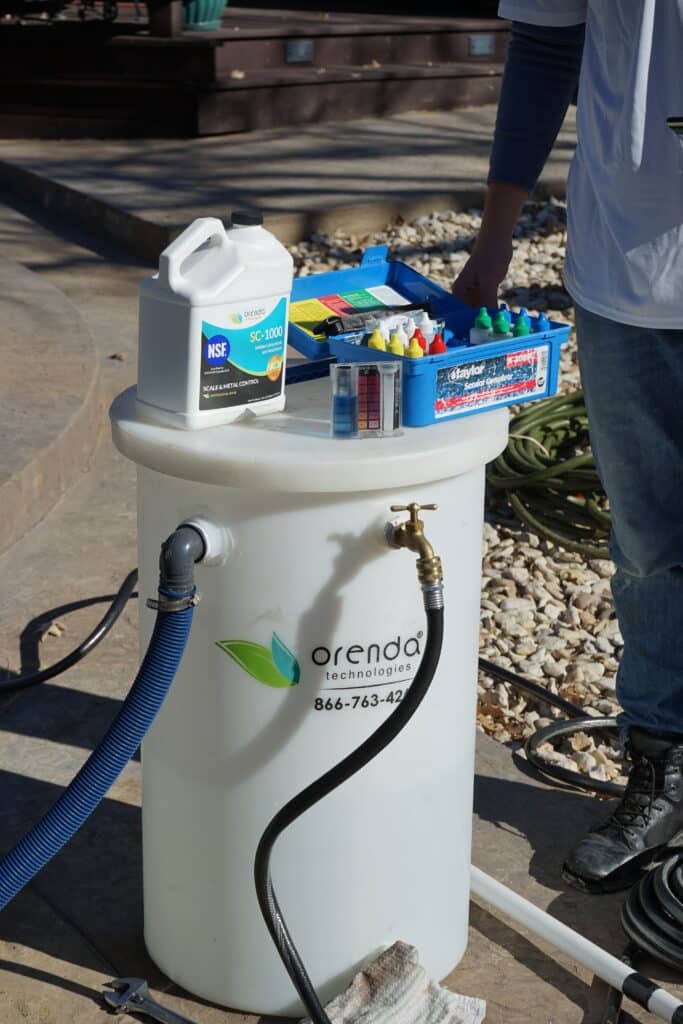Having a swimming pool at home is an exhilarating feature that, when cared for adequately, can enhance your wellbeing, lifestyle, and your property’s aesthetics. To get the most out of your pool, it’s essential to maintain the correct pH balance. This ensures a healthy pool and a safe swimming experience for everyone.
In this overview, we’ll provide insights into the significance of pH balance and guide you through the testing and adjustment processes so that you’re well-informed.
Why Pool pH Balance Matters
The pool pH level directly influences chlorine’s efficacy, a critical component for maintaining clear, sanitized water. An imbalanced pH—either too high or too low—compromises chlorine’s potency, raising the likelihood of bacterial contamination, viral transmission and algae infestation. High pH might lead to skin and eye discomfort, while a low pH can erode pool fixtures and harm the pool’s finish.
An imbalanced pH in swimming pools creates an environment that’s not just unhealthy for swimmers, but also for the longevity and appearance of the pool itself.
1. Impact on Chlorine’s Efficacy: The primary role of chlorine in pools is to disinfect and kill harmful bacteria and pathogens that could cause diseases. When the pH level is not balanced, chlorine can’t perform this function effectively. A pH that is too high decreases the ability of chlorine to kill bacteria, while a pH that’s too low can cause chlorine to dissipate quickly, reducing its sanitizing power. This leads to an unhealthy environment where bacteria and other microorganisms thrive.
2. Formation of Harmful Byproducts: Chlorine reacts with organic matter in the pool (like sweat, urine, and other contaminants) to form chloramines. While chloramines are responsible for the ‘chlorine smell’ many associate with pools, their formation is particularly exacerbated in pools with imbalanced pH. High levels of chloramines can cause respiratory problems, skin irritations, and even aggravate asthma.
3. Algae Growth: An imbalance provides a conducive environment for algae to grow. Not only do these microorganisms make the pool look unsightly and green, but they also make surfaces slippery, increasing the risk of accidents. Plus, algae consume chlorine, demanding higher amounts to keep the pool sanitized.
4. Irritation to Swimmers: High levels can make the water feel slippery and can lead to skin and eye irritations. On the other hand, a low reading can cause the water to become corrosive, leading to a stinging sensation in the eyes and making the water uncomfortable for swimmers.
5. Damage to Pool Equipment and Infrastructure: A low reading indicates acidic water, which can be corrosive. Over time, this acidic environment can deteriorate metal ladders, handrails, pump components, and even the pool liner. On the flip side, a high reading can lead to calcium precipitation, causing scale formation on pool surfaces and clogging filters.
In essence, maintaining a balanced pH isn’t just about ensuring clear water. It plays a pivotal role in ensuring that the pool remains a safe and healthy environment for everyone. Regular testing and adjustments are critical for the wellness of both the pool and its users.
How to Test
Routine pool water tests are vital to ensure it remains within the ideal range of 7.2 to 7.8, safeguarding its usability. While home test kits offer a glimpse of your pool’s chemical balance, a comprehensive assessment is best left to local pool experts, like the Certified Pool Operators at Clear Impressions. They’ll need a water sample to evaluate vital chemical levels, including chlorine, pH, alkalinity, cyanuric acid, salt, and calcium hardness.
Ways to Modify
When your pool water shows a high reading, it’s time to introduce an acidic agent like muriatic acid or sodium bisulfate. Conversely, for a low reading, an alkaline substance like sodium carbonate is needed. Given the sensitivity of these chemicals, heed the manufacturer’s guidelines or consider enlisting an expert. Introduce chemicals gradually, consistently checking the pH, to avoid over-adjustment which can be challenging to rectify. Clear Impressions recommends using a calculator like this LSI calculator from Orenda.
Tips for Balance & Maintenance
Consistent maintenance demands regular testing and adjustment. Ideally, test your pool water weekly, particularly during high swim seasons. After substantial rainfall or heightened pool activity, an additional test is recommended.
Factors like pool surface material, chemical types used, aeration from water features and water temperature can also alter your readings. Remember, an abrupt temperature surge might elevate the pH and the opposite is true as well. So, vigilance in monitoring and adjusting pH as these factors change is paramount.
Consistently managing the right pH ensures your pool remains pristine, transparent, and swim-ready. Regular checks and timely interventions help stave off issues like bacterial infections, algae blooms, and potential equipment damage. By heeding the advice outlined here, you’re on your way to preserving optimal levels, guaranteeing a delightful swimming session for everyone.
Final Thoughts
To learn more about our extensive and diverse offerings – from weekly service to our uniquely premium all-inclusive poolcare packages – feel free to contact us anytime by call or text: 682.204.9898
If you would like more helpful information about your pool, check our blog for more posts or you can listen to Pool Guy Podcast here.





